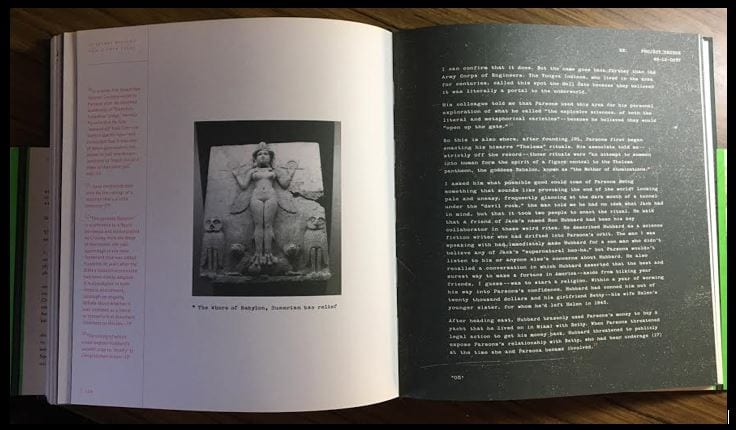Welcome back to our monthly Secrets and Mysteries series, where it is our goal to offer in-depth looks into Mark Frost’s The Secret History of Twin Peaks: A Novel section by section. As these each engage with the novel’s plot, giving close examination of its connections to the overall narrative of Twin Peaks, new readers should be aware that there will be MAJOR SPOILERS particularly about Jack Parsons and The Babylon Working. Peek beyond the red curtain at your own discretion.
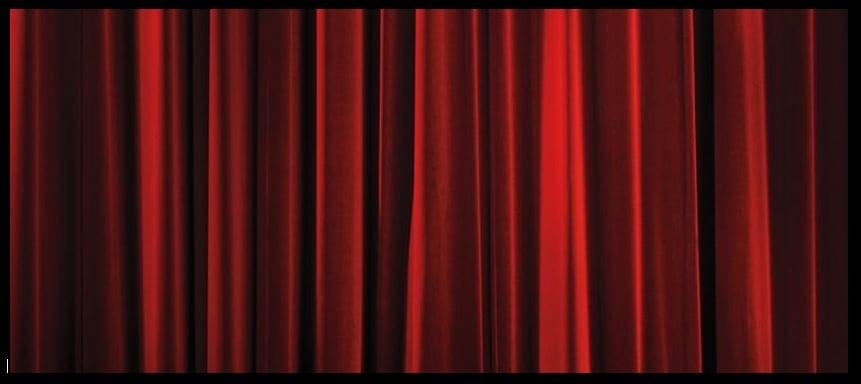
Fans were officially made aware of the coming of Mark Frost’s The Secret History of Twin Peaks on July 27, 2016, with a teaser trailer[1]. Within minutes of its release, fans poured over frozen frames to inspect its documents’ metadata—a picture of Chief Joseph of the Nez Perce Indians, a return postage form from Gordon Cole, a receipt for Douglas Milford’s 1947 Buick Roadmaster, etcetera. Speculation filled the air of fandom waiting for Season 3. No further official clue would come until Flatiron Books released another intriguing, 15-second trailer over Twitter on September 13th[2], replete with its single quote by none other than Marvel John “Jack” Whiteside Parsons hovering over an ominous, animated Red Room accompanied by slow creaking music. The quote: “We saw things that maybe men aren’t supposed to see.” It would take the entirety of the novel to capture Frost’s full perspective on this strange history, and while Parsons’s quote appeared as a first in the series of Flatiron Books teaser trailers, fans would not learn more about his role until reaching the latter pages of 239-271. As a quick aside, the animated papier-mâché effect of the Red Room floor in the teaser made for a then-unsuspected foreshadowing of how its floors would react beneath Cooper’s feet in Part 2 under the influence of The Evolution of the Arm’s “non-Exist-ence” incantation.
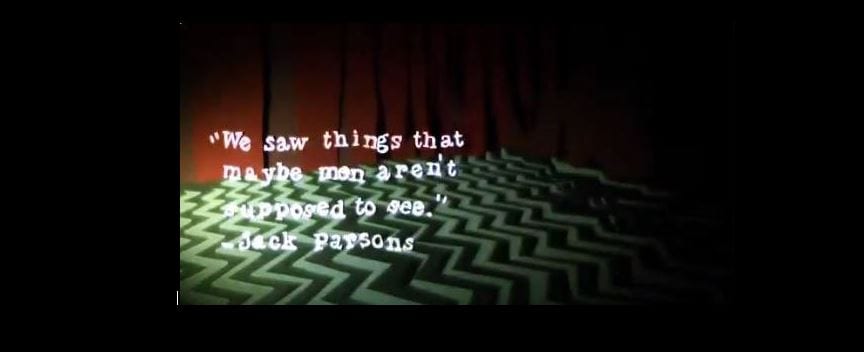
Those wanting to read full biographies on Parsons will find two complementary works: George Pendle’s Strange Angel: The Otherworldly Life of Rocket Scientist John Whiteside Parsons by Houghton Mifflin Harcourt and John Carter’s and Robert Anton Wilson’s Sex and Rockets: The Occult World of Jack Parsons by Feral House. It was announced during August of 2017 that the paid service CBS All-Access had ordered an adapted drama to series titled Strange Angel from George Pendle’s biography. To date, it is set to premiere June 14th, about a month and a half from the publication of this write-up. [As an extension of this article, I will cover that particular series for 25 Years Later upon its release.] And while this will be a strong lead-in to that series, this article explores Mark Frost’s rendering of the history through his novel with its connections to the fictional world of Twin Peaks. Specifically, the focus here are the documents presented by “The Archivist” as well as the field report of Major Douglas Milford found on the pages mentioned above.
Project Grudge & Letter from House Member Nixon to General Twinning, 11/12/1949 (p. 240)
In this portion of the novel, UFO Project Sign finds its reports to the “top brass” of the Air Force rejected. The program is renamed Project Grudge with an order to discredit and debunk claims of UFOs and all that entails. This date in Twin Peaks history is November 1949, when a letter arrives at Wright-Patterson Air Force Base from the Office of the Honorable Richard M. Nixon of the House of Representatives to General Twinning. At this time, Nixon is working on the House Un-American Activities Committee (HUAC), which was formed a decade earlier to identify citizens engaged in Communism or broadly-defined subversive activities. Nixon informs General Twinning that certain high-level threats can require extreme sensitivity and discretion. His attention is drawn to Jet Propulsion Laboratories (JPL) in Pasadena, California, an increasingly important research facility for the United States’ rocket science program, which of course influences military efforts. It is explained to Twinning that his most dependable and experienced officers “should be entrusted with this” information. Think Douglas Milford.
Included is a recorded interview between Nixon and Navy Lieutenant Lafayette Ronald Hubbard. As an audience, I remind you that this document is presented by the fictional character of “The Archivist” as part of Mark Frost’s epistolary novel. Still, before diving into that account, we should note two important pieces of history that, while covered in more depth further into this write-up, are offered to us here. One, the Church of Scientology has admitted to Hubbard’s relationship with Parsons, while adamantly stating that his involvement with The Parsonage or any ritual therein was as an embedded military agent. As further stated by Carole M. Cusack in her article “Scientology and Sex: The Second Dynamic, Prenatal Engrams, and the Sea Org,” “In December 1969, the Church of Scientology placed a statement in the London Sunday Times … acknowledging Hubbard’s association with a group of ‘black magic’ practitioners in Pasadena but claiming that he was working for the United States intelligence services at that time. ‘Hubbard’s mission was successful far beyond anyone’s expectations. … Hubbard rescued a girl they were using. The black magic group was dispersed and destroyed.’”[3] Two, Parsons met an untimely death attributed to a clumsy mistake that has been roundly questioned considering his expertise. Nixon’s contact of Twinning suggests he understands Major Milford’s previous assignments and expertise regarding these “sensitive” matters. See previous efforts of Milford’s in our Secret History analysis titled “The Secret History of Twin Peaks: UFOs, Conspiracy, and the Players, p. 86-123 (Secrets and Mysteries, Part 3).” If HUAC deemed parsons as a high priority, perhaps a Man in Black might be required to investigate and end such matters judiciously, meaning terminally.
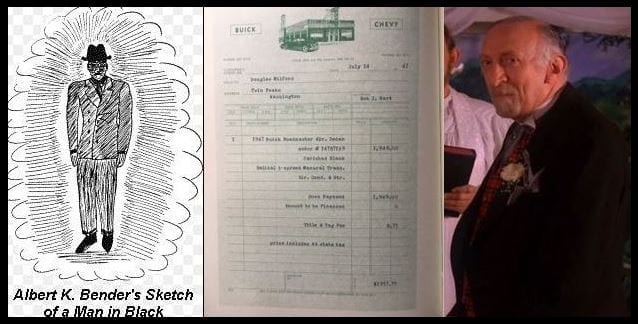
Nixon’s Interview with Lt. Hubbard, Ref # 49-0351 Date: 10-17-49 (p. 241-244)
For anyone thinking they understand Frost’s position on Hubbard, it seems strange that here we have Hubbard helping the United States government as an inside informant, indeed, as the Church of Scientology has claimed. Still, while this is a fictionalized document in the novel, we have to understand, as I’ve pointed out in discussing UFOlogy, that per the narrative of Twin Peaks, we have to consider all fact and fictions alike. Furthermore, it is Agent Tamara Preston’s job to sort it. Here, Hubbard informs Nixon of Parsons’s full name, explaining that they met through other writers in August of 1945. Hubbard was working as a science fiction author at this time. This is confirmed in Sex and Rockets, where we are informed that “In late August of 1945, Lou Goldstone brought L. Ron Hubbard over to meet Parsons, who liked Hubbard immediately.”[4] Nixon is familiar with Parsons’s name and his role as a chemist and co-founder of JPL. We get our first mention of “The Parsonage,” Jack Parsons’s mansion, bohemian lodge, and “church” of Thelema (a.k.a. Agape Lodge). Nixon continues to learn of Parsons’s more secretive association with Aleister Crowly and his Thelemic belief system. Part of Hubbard’s testimony includes living in “The Parsonage” during a time of financial difficulty. Upon being asked by Nixon if he has reported the strange activities—“Openly partaking of various drugs. The practice of free love and the periodic enactment of bizarre “sex magick rituals.”[5]—he admits that authorities visited The Parsonage on many occasions to no avail. This is also confirmed in Sex and Rockets.
As early as 1941, Parsons was investigated (at his previous residence), but no arrests were made … In 1942, local police came to 1003 S. Orange Grove to investigate an alleged backyard ceremony wherein a pregnant woman had reportedly jumped nude through a fire nine times. The police made it clear that they thought the claim absurd and that they were only investigating because it was their duty … Again the police investigated but found Parsons’ “cult” to be little more than “an organization dedicated to religious and philosophical speculation, with respectable members such as a Pasadena bank president, doctors, lawyers, and Hollywood actors.” The actor John Carradine, for example, read one of Crowley’s poems at the inauguration of Agape Lodge No. 2 in 1935 … In September 1942, the Pasadena police received an anonymous tip via a letter sent by an ex-member of the Agape Lodge bearing the signature “A Real Soldier” and postmarked San Antonio, Texas that accused Parsons of “black magic and sex orgies.” Once again, Parsons was cleared of all charges.[6]
This brief interview leads us to the next document on page 245, a field report by Lt. Hubbard.
Hubbard’s Field Report, Ref # 002-45 (p. 245)
There is a heft of information in Hubbard’s account, at least enough to start Milford on his investigation. Hubbard allows that with the war over, Parsons has little to do with the day to day goings-on of JPL but continues as a consultant to old associates, members of the “Suicide Squad,” the crew of those scientists that worked with him on experiments before rocket science was taken seriously. For some context, let’s look to this encompassing quote from Pendle’s Strange Angel.
Jack Parsons was just such a figure, living on the cusp between an old world in which the very idea of space travel was a scientific absurdity and a new world in which it would become scientific fact. It was this new world which, despite his lack of a university degree or professional scientific qualifications, he would help to create. Along with his motley band of experimenters, disparagingly known as the “Suicide Squad,” he revolutionized the public and academic perception of rocketry, transforming it from an object of ridicule into a viable science. In the process Parsons invented a radically new kind of fuel, the descendants of which are still used in the space shuttle to this day, and helped found the Jet Propulsion Laboratory at Caltech, which has since become the world’s preeminent institution for the exploration of the solar system. In many respects the United States’ path to the moon landings began with him. In the words of the great scientist Theodore von Kármán, after the work of Parsons and his partners, “a new age was born.”[7]
Let’s also note for the time period what helped to end the war as it also defined the new age. Was it not atomic sciences, such as what was explored at White Sands Missile Range in New Mexico and later unleashed on Hiroshima in 1945? Given that, let’s also make a note of Hubbard’s own self-proclaimed biography, which we will return to.
Born in Nebraska in 1911, Hubbard claimed to have been initiated by Blackfoot shamans in Montana, then to have traveled widely in Asia and learned the secrets of Eastern sages, Buddhist priests, and ‘the last remaining magician from the line of Kublai Khan’s court.’ Back in the United States, he pursued the sciences, studying engineering and atomic physics at George Washington University before enjoying a decorated naval career during World War II.[8]
At the time of the Suicide Squad, Hubbard explains, Parsons was known as a master of working with dangerous and combustible chemicals, which he referred to as “alchemical elixirs,” and we refer to as fuel. His sciences later led to military efforts as they aided in jet-assisted take-off. Then again, here, Hubbard makes note of his consideration of Parsons as being “stark, raving mad,” a curious balance of admiration and admonishment. He continues this scoffing, referring in our second mentioning of The Parsonage church as a “coven.” Hubbard claims that Parsons’s first contact with the occult came in 1939. What we know for sure is that “John and Helen Parsons joined the Agape Lodge on February 15, 1941, when they simultaneously joined the A∴A∴.”[9] A∴A∴ stands for Astrum Argenteum and is known as an Order, or organization, whose goals are to advance humankind through spiritual evolution. They were described by Aleister Crowley, an important name for this report, as early as 1907. Hubbard goes on to mention that “Parsons is fond of stomping feet while reciting a poem called ‘Ode to Pan’ during test launches.” It is known that Parsons had an ability to recite these poems from memory, an ability often called upon at The Parsonage. In this portion of the field report, Parsons is stated to recite the Thelemic Law to Hubbard, at which point Hubbard notes he is “worrying a ring on his right ring finger, a flat green stone, maybe jade etched with some sort of inscription.”[10] Jack Parsons explains to Hubbard that what rockets and magick have in common is to transcend all limits. Hubbard notes:
(He takes what looks like an ancient silver coin from his pocket and performs some kind of slight of hand with it; suddenly there are two coins.) … (He stares at me a moment with his dark brown eyes, then turns his gaze to the statue of Pan, gets a faraway look and mutters something under his breath.) JP: The magician longs to see … I’ve often felt there were spirits in this wood … [11]
While all of this fits into our Twin Peaks narrative, it is clearly defined here as Parsons is stated to quote from the original lodge denizen incantation “From the darkness of futures past, the magician longs to see; One chants out between two worlds, fire walk with me.” Of course, the ring he worries on his finger is in reference to the Owl Cave signet ring. I have read in the past of fans debating a connection between Parsons’s connections to the Red Room and its decoration—the World’s Fair Saturn lamp, the chairs, the shell table seen holding the ring and where BOB sends Windom Earle’s soul. Now to address the coin trick. It would be difficult knowing the full imagery of Twin Peaks not to be reminded of Red’s coin trick performed for Richard Horne in Part 6 of The Return. Could we now tie this awkward magical trick into an association with Thelemic “magick” through Parsons? I’ve previously alluded to a connection between Hank Bartells of Ronnie Rocket and Red in The Return, but is Frost guiding our attention? He is certainly raising rather curious flags.
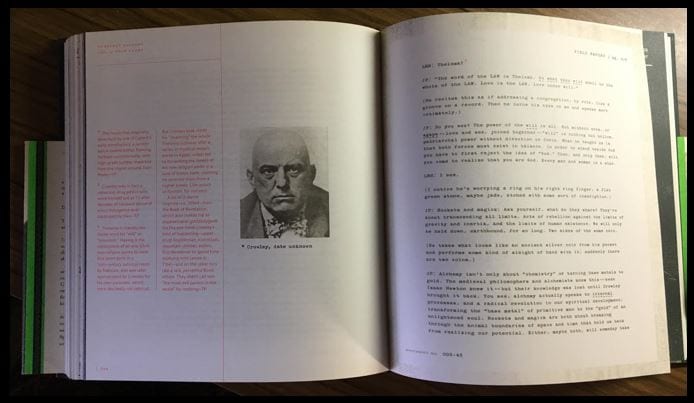
Archivist’s Note: (p. 252)
The Archivist advances our story here. We have our first mention of a confidence trick taking place, but the place to lay that out, including claims of rituals brought into Scientology, is later. It’s a little out of order to have all of this stated here, but let’s examine the Archivist’s thoughts. The Archivist does notice the suspicious late reporting by Lt. Hubbard. Note his report to Nixon took place in 1949. As stated, The Archivist notes Hubbard’s con on Parsons, but that can be addressed better below. We can note that the Archivist sees occult involvement as “mumbo-jumbo,” which is interesting, considering how Major Briggs—if we are to truly believe he is the later revealed Archivist—chooses to approach the wonderful and strange elements in the woods of Twin Peaks. Still, here is some important reporting from the Archivist. 1) Jack Parsons came under suspicion of selling secrets of the rocket program to foreign governments. This is likely coming from investigations from HUAC. He would be acquitted. 2) In light of that event, JPL terminated its relationship with him, the results of which would force him to sell The Parsonage. 3) His financial difficulties in large part were a result of Hubbard’s confidence trick on him. He sues to get some of it back. 4) At this point in the history, it is time for Parsons’s security clearance to come up for renewal. Project Grudge dispatches Major Douglas Milford to investigate and report back, leading to our next weighty section for examination.
Project Grudge Report, Ref # 49-12-0037 (p. 253-262)
Milford’s report is dated for December 03, 1949. He notes that Jack is now living in a meagre apartment by the beach, working as a consultant. Milford does not approach him from an official stand-point. Rather, he approaches him as a journalist for a “left-wing magazine.” It is probably safe to say that “left-wing” had a more radical connotation than it does today. This might have even insinuated communist-leanings as an appeal to Parsons’s interests. Parsons was glad to tell his side of the story and agreed to meet Milford at a Manhattan Beach coffee shop. According to Jack’s side of the story, Hubbard was only too eager to jump into his church, and this is where we begin to pay strict attention. Parsons explains to Milford that Crowley had written about an important ritual that “The Great Beast,” himself—Aleister Crowley—had not attempted. Milford’s curiosity is piqued at the mention of the ritual and asks about Hubbard’s participation, which Parsons confirms. Following is the line from the teaser trailer. (Pardon the long quotation. There is really no way to contextualize without it.)
JP: We saw things that maybe men aren’t supposed to see.
DM: Where was this?
JP: Out in the desert. The desert’s a perfect medium for summoning … an empty canvas, a beaker into which, under certain circumstances and with fearless rigor, you can create an elixir that will call forth … call them what you will … messengers of the gods …
DM: (I laughed nervously) Wow. What does that look like?
JP: Oh, they assume many forms. The grays, for instance. You know, Zeta Reticulans. (Continues) The tall ones, now, the Nordic types, they’re different. More benign. Some say they’ve always been here. Supposedly they come from the Dog Star. (I notice he’s sweating heavily as he says this and his eyes have taken on a glassy sheen. I wonder if he’s on drugs right now.)
DM: The Dog Star?
JP: Serious.
DM: Yes, I’m serious. (Slight laughter from Parsons, but I’m not sure why.)
JP: Ever been to Roswell?
DM: Roswell, New Mexico? As a matter of fact, I have.
JP: We were near there. In the desert. A place they call Jornada del Muerto.
DM: That’s near White Sands, isn’t it?
JP: Right. It means “Journey of the Dead Man.” Isn’t that beautiful? The way we all move through our lives. Eyes closed, head down, shuffling along. Dead before our time, journeying toward the grave.
DM: That’s where they tested the bomb.
JP: Yes. (The faraway look again, eyes unfocused) Such a fertile ground for the Working.
DM: Pardon? What’s the Working?
JP: The ritual. The Working of Babalon. Calling forth the Elemental.[12]
Our article takes an interesting turn here. For those of your who have pondered since this novel’s release what any of this means, I can only direct your attention to possibilities without solid answers. Still, let’s begin the examination of the passage above.
In the world of Twin Peaks and in United States conspiratorial history there is a very important range of years we must acknowledge, those of 1945-1947 specifically, then 1956 as specific to Twin Peaks. The Trinity Test of The Return’s Part 8 occurs in 1945; the Babylon Working was performed in 1946; the Roswell UFO crash occurred in 1947, along with many other sightings specific to the Pacific Northwest, which are covered in Part 3 of our Secrets and Mysteries series linked above; Then, the Black Lodge Woodsmen incident occurred outside of Los Alamos which led to (according to the Final Dossier, at least) Sarah Palmer’s body possession/infection/bestowal(?) in 1956. Specific to the 1940’s range is also a location in the state of New Mexico. In my travel piece on the Southwest narrative of Twin Peaks—some of these build upon each other—I quote a statement on the Babylon Working. “To quote from the Roads and Kingdoms blog site, ‘The site of the Babalon Working ritual is disputed. Parsons’ biographers place it in the Mojave Desert, yet occultist forums, desirous of synchronicities, suggest it happened on the site of what is now Area 51.’[13]” Here, though, Mark Frost gives us a definite location in New Mexico, that of the desert known as Jornada del Muerto, “Journey of the Dead Man.” Both L. Ron Hubbard and Jack Parsons performed the ritual from January to March 1946, “…which had as its goal to shatter the boundaries of time and space to bring about the incarnation of the “magickal child,” or Thelemic messiah, that Crowley had described as the herald of the New Aeon of Horus.”[14] This location puts me in the mind of my colleague, Simon Baré’s article “In the Between,” where he explains that “Within anthropology, liminality is, as a concept, specifically related to and located within traditional ritual, ceremonial and spiritual practice. … Victor Turner … applies the term liminality specifically to ‘generalised ritual and social performativity”[15]. This is simply to claim that as an extension of my Southwest Tour for Twin Peaks fans, one might also plan a trip to the Jornada del Muerto desert outside of Truth or Consequences, NM as it is certainly a liminal space for the series.

Now, Urban continues: “Using the powerful energy of IX degree Sex Magick, the rites were intended to open a doorway through which the goddess Babalon herself might appear in human form. Incarnate as a living female, Babalon would then become the Scarlet Woman and consort of the Antichrist (a role Parsons would later claim for himself).”[16] I think this is important to understand that this goal of shattering the boundaries of time and space and the intended open doorway in this liminal space may very well apply to a couple of areas in Twin Peaks. 1) The New York box. Some have wondered if the sexual energy between Sam and Tracey brought about the presence of Mother/The Experiment/Judy, or Zeta Reticulan as Parsons would have it, in Part 2 of The Return. It is possible if The Double or Tracey was attempting to capture Judy in the same way Parsons intended but through technology. Though I believe we’ll see the ritual is much more than simple sex. It’s up for continued debate. 2) The added conjunction of humanity’s ignorance in the Trinity Test to shatter time and space, then Parsons’s audacity to set Judy and her denizens free.
Remember The Little Man From Another Place’s chant in The Missing Pieces “From Pure air … we have descended … from pure air. Going up and down … Intercourse between two worlds.” Parsons gets his little joke out of Milford when he brings up the Dog Star as an origin place for the “tall ones … the Nordic types,” Dog Star referring to Sirius, which Milford hears as “serious.” According to Carter and Wilson “Two chapters survive of Parsons’ original The Book of Babalon. One, “The Star of Babalon,” is in Freedom Is A Two-Edged Sword. It consists of directions from Babalon to the expected Magical Child, and is not to be confused with Parsons’ record of the Babalon Working.”[17] Here, we now have the actual star Sirius as an origin point for the denizens or a chapter, “The Star of Babalon,” which is directions to the Magical Child. But still, “from pure air.” The ritual would begin on January 4, 1946, at 9:00 p.m.
To begin the working, Parsons chose one of the squares from the Enochian “Air Tablet”… Parsons first invoked the “Pentagram of Air,” a five-pointed star traced in the air with the dagger. … Parsons probably should have invoked with the hexagram next, which is the way the rite usually goes, but he does not record this being done. … Next Parsons recited from memory the “Invocation of the Bornless One,” a short invocation translated by Crowley and appearing at the beginning of his and Mathers’ translation of the Goetia, or Lesser Key of Solomon. … Parsons next recorded a “Conjuration of Air,” a “Consecration of the Air Dagger” (apparently a redundancy), and the Key Call of the Third Aire, the latter of which is not to be confused with the element Air. … Next was an Invocation of God and of the King associated with the Air Tablet. … Parsons next invoked the Six Seniors of the Air Tablet, whose names are HABIORO, AAOZXAIF, HTNMORDA, AHAOZAPI, AVTOTAR, and HIPOTGA. They are equivalent to the “airy” parts of Mars, Jupiter, the Moon, Venus, Mercury, and Saturn, respectively—six of the seven “planets” visible to the naked eye, the seventh (the King) being the Sun, the same as the seven days of the week, albeit in a different order.[18]
I will only quote from Sex and Rockets one last time but will do so only as it is important to us sorting out Mark Frost’s steering in The Secret History of Twin Peaks.
Project Grudge Report, Ref # 49-12-0037 (p. 256-262)
We are due one more perspective on Parsons’s story, from a trusted colleague. Douglas Milford continues to report that he met with this colleague, who worked with Parsons from the mid-1930s as part of the “Suicide Squad.” The colleague takes Milford out to the Arroyo Seco near JPL labs. The destination is known as “Devil’s Gate.” Several reasons are given for the name of the spot, none of which offer us more than coincidence and Parsons’ poetic romanticism for using the spot in early Thelemic rituals. Milford’s report began with Nixon’s concerns incited by Hubbard’s late testimony in 1949. Doug Milford gets a much clearer perspective on the mentioned “confidence trick” played on Parsons here. Perhaps Frost did manage to get his position stated in this portion. According to Milford’s report:
… it took two people to enact the ritual. He said that a friend of Jack’s named Ron Hubbard had been his key collaborator in these weird rites. … The man I was speaking with had immediately made Hubbard for a con man who didn’t believe any of Jack’s “supernatural hoo-ha,” but Parsons wouldn’t listen to his or anyone else’s concerns about Hubbard. … Within a year of worming his way into Parsons’s confidence, Hubbard had conned him out of twenty thousand dollars and his girlfriend Betty–his wife Helen’s younger sister, for whom he’d left Helen in 1945.[19]
So, what are we to believe about this character of Hubbard, who puts the military onto Parsons’s trail, redacting his participation completely, except for his own Church’s admission of his involvement under the impression that he rescued Betty and broke up this Black Magic circle? Let’s look back to a point I skipped in The Babylon Working portion from Sex and Rockets.
January 14 was the second-to-last day of the working—a very interesting day. As Parsons began invoking at 9 p.m., the electricity went out. Parsons records that “another magician who had been staying in the house and studying with me was carrying a candle across the kitchen when he was struck strongly on the right shoulder, and the candle knocked out of his hand.” According to Cameron and others, this other magician was Hubbard, which is odd in that Hubbard was consistently referred to as “Scribe” throughout Parsons’ record of the Babalon Working, rather than “magician,” indicating the record may have been garbled here.[20]
The electricity went out. In fact, Marjorie Cameron, Parsons’s new lover and supposed product of the Parsons’s first Babylon Working claims Hubbard as having the role of “magician.” Now, remember Hubbard’s strange biography. According to Cusack in her paper “Scientology and Sex: The Second Dynamic, Prenatal Engrams, and the Sea Org,” There is a lot to consider there.
Critics argue that virtually every ‘‘fact’’ in the official Church of Scientology biography of Hubbard is actually a fabrication, and in the legal case Church of Scientology of California v. Gerald Armstrong (1984), Judge Paul Breckenridge deemed Hubbard ‘‘a pathological liar when it comes to his history, background and achievements.’’25 Similar tales of travel, adventure, and enlightenment are told of Theosophical Society co-founder Madame Helena Petrovna Blavatsky (1831–1891) and spiritual teacher George Ivanovitch Gurdjieff (1866?–1949), testifying to their appropriateness for the genre of biographies of founders and teachers of new religious movements.[21]
Note Hubbard’s description as a “scribe” or “seer.” Aleister Crowley early on suspected Hubbard of his con. Parsons’s defense of Hubbard was that he had made contact with his Guardian Angel. This is an important step in Crowley’s Thelemic system. “A key part of realizing one’s true nature is attaining the knowledge of and conversation with one’s Guardian Angel.”[22] Hubbard was good at telling Parsons what he wanted to hear, and that plays well in the Church of Scientology’s assertion of Hubbard’s role, one man’s con is another man’s secret intelligence mission. But here it is a fact that Hubbard absconded with Betty. Now, let’s look at this quote in Strange Angel.
In the manner of a true follower of Thelema, Parsons had always prided himself on his ability to renounce jealousy. One needed only to look at the remnants of his first marriage to see how successfully he had managed this. Up until now, he had been quite comfortable with Betty’s amorous adventures, always confident that she would come back to him in the end. But he was disturbed by the intensity of her relationship with Hubbard. This was no mere dalliance. Parsons put on a grand show of remaining friends with her. They hugged and talked as before, and he accompanied Betty and Hubbard on trips as “the genial elder brother,” but when nighttime came, Parsons was excluded from her bed. For Alva Rogers, as for the rest of the house, it was obvious that “Jack was feeling the pangs of a hitherto unfelt passion, jealousy.”[23]
Perhaps Parsons’s answer to his jealously was to endear Hubbard to him, and for his retribution, humanity would pay with his power over the “magickal child.” We can only speculate. But I will revisit this jealousy shortly.
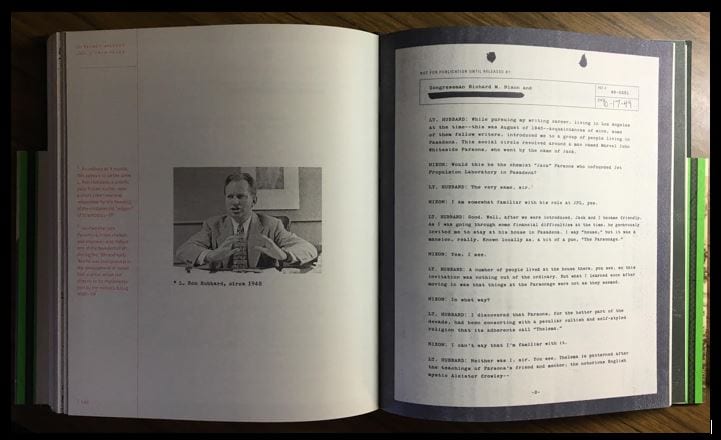
Guardian Angels
Perhaps one of the largest clues that Hubbard intended a con on Jack Parsons was his positioning of his role in the Babylon Working. He claimed the role of “seer.” This came from Parsons own words in trying to convince Aleister Crowley of Hubbard’s unique abilities as a Thelemic follower. “.. on 6 March [1946] he wrote excitedly to Crowley: ’I have been in direct touch with One who is most Holy and Beautiful mentioned in the Book of the Law … First, instructions were received direct through Ron, the seer …”[24] If Parsons was completely guided by Hubbard’s instruction based on what he was “seeing,” and what we know of his “biography,” it seems there was more than enough gullibility on Parsons’s part to be conned. In a strange text known as the “Affirmations”, or “Admissions,” of L. Ron Hubbard—better explained in Hugh’s essay “Occult Roots of Scientology?”—there is a unique passage regarding guardian angels, the same kind that Hubbard claimed to have personally communicated with to Parsons. I would like to look at it briefly as I was reminded of a scene in The Return.
Nothing can intervene between you and your Guardian. She cannot be displaced because she is too powerful. She does not control you. She advises you … You are an adept and have a wonderful and brilliant wisdom. You have the Wisdom of all and never doubt your wisdom. You have magnificent power but you are humble and calm and patient in the power. For you control all forces under you as you wish. The strength of your Guardian aids you always.53[25]
Apropos of nothing in Mark Frost’s novel—this thought is beyond his steering and directly from my research—I could not help but read that thought and consider the scene in The Return Part 10 when answering his door, Gordon Cole sees Laura in pain. It leaves me with only questions, one of which I will leave here. Is Gordon Cole, independent of Thelemic beliefs, communicating with Laura as a kind of Guardian—she to him, as in warning, not the opposite?
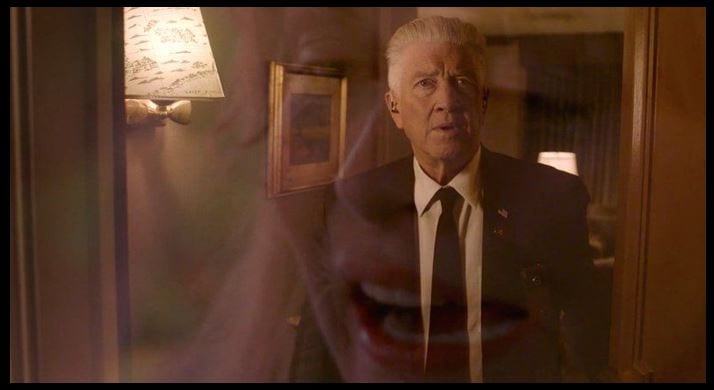
Archivist’s Note, (p. 260)
The Archivist notes the absurdity of the assertions regarding Hubbard as an embedded agent. The rest of his points are made above.
Project Grudge Report, Ref # 49-12-0037 (continued)
Douglas Milford can finally conclude his investigation, coming to the final decision to recommend Parsons’s security clearance not be renewed. The important facts he notes include finally naming the “magickal child” the “Moonchild” and the realization that Parsons had attempted to open a second gate the weekend before the UFO incident at Roswell, NM.
Archivist’s Note
“Parsons’s downward spiral continued, but another perceived threat he represented to national security prompted Major Doug Milford to make a final visit to Pasadena in 1952.”[26]
Project Grudge, Ref #52-06-0015
Major Douglas Milford gets to see the final downward spiral of Parsons in person, noting needles in his garage and his continued worrying of the green ring on his finger.
LOS ANGELES TIMES JUNE 18, 1952
This newspaper report announces the death of Marvel John “Jack” Whiteside Parsons. He died in an explosion in his garage. The cause is stated as a mishandling of a volatile explosive, which many doubt, considering his expertise. The Archivist notes that “The blast atomized his right arm, no trace of which was found, broke both his legs, caused massive internal injuries and destroyed the right side of his face, suggesting that he reached down to catch the can when it dropped before it hit the floor.” The evidence of his missing right arm and the hypodermic needles, I believe, was confirmed to a fan online by Mark Frost as alluding to Mike/Phillip Gerard of the Red Room. I cannot find that quote again, so we’ll take that will a grain of salt. The details match exactly with George Pendle’s introduction to Strange Angel, meaning Frost did not have to manipulate those details to insinuate the coincidence.
Conclusion
This leads to the next evolution of Project Sign, which became Project Grudge, which would then become Project Blue Book, and Project Blue Book brings me to a point here. It seems to me that the culmination of this story is that these were powerful years—1945-1947: Trinity & the UFO Roswell incident. If Parsons was influenced by Mike of the evil arm, then Windom Earle was equally a man bent on loosening the Lodges’ powers as a rogue agent. We remember his insanity began during his work with Project Blue Book upon learning of the Black and White Lodges. We also remember the furthering of his insanity as he manipulated the relationship between his wife, Caroline, and Agent Dale Cooper. I am a lot more comfortable equating Parsons, Hubbard, and Windom Earle’s efforts to each other. Think on Parsons’ deep jealousy of Hubbard and Betty’s relationship. His answer was to invite him into his magickal working. Humanity would pay for their betrayal. In each of these scenarios, a magician’s selfish actions aided the larger whole regardless of them. They were expendable, simple pieces on a chessboard to release the Mother in one instance and capture Cooper in another. Laura Palmer’s relationship to the Babylon Working has been subject of great works since the release of The Secret History of Twin Peaks and The Return Part 8. That particular part and this portion of the novel are inseparable. Frost has stated that Part 8 is a kind of origin story for the evil in Twin Peaks, and this dark chapter is no less than the story of humanity’s selfish and audacious folly serving the greater purposes of that evil.
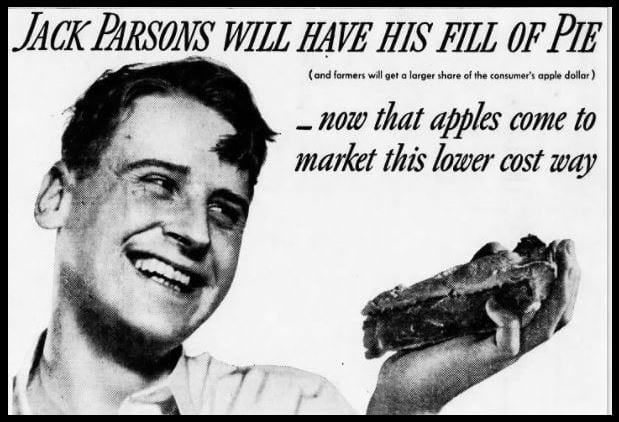
[1] [See the trailer here: https://www.youtube.com/watch?v=kinf5ApBjmg]
[2] [See the trailer here: https://twitter.com/Flatironbooks/status/775724278356537346]
[3] Cusack, Carole M., “Scientology and Sex: The Second Dynamic, Prenatal Engrams, and the Sea Org,” Nova Religio: The Journal of Alternative and Emergent Religions 20, no. 2 (2016): 10-11.
[4] Carter, John, Robert Anton Wilson. Sex and Rockets: The Occult World of Jack Parsons, (Port Townsend, WA: Feral House, 2004): 101.
[5] Frost, Mark. The Secret History of Twin Peaks (New York: Flatiron Books, 2016): 244.
[6] Carter and Wilson, p. 87-88.
[7] Pendle, George. Strange Angel: The Otherworldly Life of Rocket Scientist John Whiteside Parsons, (New York: Houghton Mifflin Harcourt, 2013): 15.
[8] Urban, Hugh B. “The Occult Roots of Scientology? L. Ron Hubbard, Aleister Crowley, and the Origins of a Controversial New Religion,” Nova Religio: The Journal of Alternative and Emergent Religions 15, no. 3 (2012): 94.
[9] Carter and Wilson, p. 56.
[10] Frost, p. 249.
[11] Frost, p. 250.
[12] Frost, 254-255.
[13] Owens, Jay. “Atomic California” (Roads & Kingdoms, October 19, 2015), Accessed April 09, 2018, http://roadsandkingdoms.com/2015/atomic-california/
[14] Urban, Hugh B. Magia Seexualis: Sex, Magic, and Liberation in Modern Western Esotericism, (California: University of California Press, 2006): 136-137.
[15] Baré, Simon. “In the Between,” (25 Years Later, April 19, 2018), Accessed April 26, 2018, https://25yearslatersite.com/2018/04/19/in-the-between/
[16] Urban, Magia Seexualis, p. 137.
[17] Carter and Wildon, p. 134.
[18] Carter and Wilson, p. 119-122.
[19] Frost, 259.
[20] Carter and Wilson, p. 126.
[21] Cusack, p. 9.
[22] Hugh, “Occult Roots of Scientology?” p. 96.
[23] Pendle, p. 256.
[24] Hugh, “Occult Roots of Scientology?” p. 98.
[25] Hugh, “Occult Roots of Scientology?” p. 100.
[26] Frost, 265.
